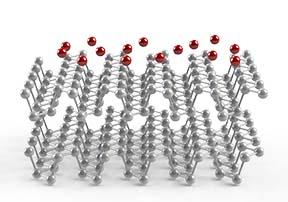BLACK PHOSPHORUS: THE NEW GRAPHENE?
Posted Paulcnblogs
tags:
篇首语:本文由小常识网(cha138.com)小编为大家整理,主要介绍了BLACK PHOSPHORUS: THE NEW GRAPHENE?相关的知识,希望对你有一定的参考价值。

Black phosphorus is coming to prominence in the field of 2D materials, as Simon Frost reports.
A research team at Pohang University of Science and Technology (POSTECH), South Korea, has formed a tuneable band gap in the 2D material black phosphorus (BP) that could make it suitable for flexible electronic and optoelectronic devices.
BP is made by heating red phosphorus – the material used for the head of a match – at high pressure. In its single layer form it is known as phosphorene, and is arranged in a honeycomb atomic structure similar to that of graphene.
But there is a key difference between the two materials – while BP has a natural band gap, graphene, in its pristine state, has a band gap of zero. POSTECH Professor Keun Su Kim, explains, ‘Because of this, one can flow current in graphene very efficiently, but it is extremely difficult to switch off this conduction.’ This inflexibility makes graphene a difficult candidate for semiconducting materials, which require their conductivity to be switched on or off. ‘Researchers have tried to open a band gap in graphene, but so far it turns out to be difficult without degrading the material’s quality’, says Kim.
Antonios Oikonomou, Research Associate at the University of Manchester’s National Graphene Institute, UK, says of graphene’s band gap issue, ‘Indeed, pristine graphene faces challenges in its application in digital electronics (logic transistors) due to its zero band gap. This is responsible for the low on/off non-zero off state drain current in graphene field-effect transistors, which leads to considerable power dissipation.’
But graphene’s band gap issue, he says, does not make it as unworkable as one might think. ‘Over the past years, a number of band gap engineering strategies have been explored successfully, such as quantum confinement (graphene nanoribbons and graphene quantum dots), substrate-induced band gap, molecular doping/charge transfer methods and selective chemical functionalisation.’
Inspired by graphene
Professor Kim’s team had another idea for creating a highly conductive material that could work as a semiconductor. ‘The alternative approach to this problem is to start with a 2D semiconductor with a natural band gap and then modify its properties similar to that of graphene.’
The team opted for black phosphorus. ‘The honeycomb structure of black phosophorus is regularly puckered. This makes it highly susceptible to external perturbations such as strain and electric field. We deposited potassium atoms on the surface of black phosphorus to induce a strong electric field nearby, and this applied electric field changed the distribution of electrons.’ When the band gap approached zero, the researchers observed Dirac semimetal state – the unique quantum state of matter responsible for graphene’s high conductivity – and therefore achieved a tuneable band gap in black phosphorus. ‘This means that one can induce the important properties of graphene into another 2D material that is more flexible,’ says Kim.
Rise in patents
While researchers are now inducing the properties of graphene in other 2D materials, graphene remains the popular leader in the field. The number of international patent applications involving graphene published by the World Intellectual Property Organization has risen from 22 in 2005 to 4,051 in 2014. Nick Braddon, a patent attorney specialising in materials science and metallurgy for Barker Brettell, UK, says, ‘The applications for graphene that are attracting the most significant R&D interest appear to be in the fields of semiconductor devices, electric solid state devices and processes or means – for example, betteries, for the direct conversion of chemical energy into electrical energy. Perhaps, therefore, we can expect to see graphene and other 2D materials being used in these technology areas before long.’
But Braddon also notes that graphene’s popularity may have somewhat skewed the figures relating to patents. ‘The ongoing interest in graphene as a “wonder material” may have made it something of a buzzword, which will have been included in some patent applications as a possible (potentially speculative) variation of an invention, as opposed to graphene being at the core of the invention.’
A surge ahead?
Of wide reports that the POSTECH research signals a ‘surge ahead‘ of graphene by BP, Oikonomou says, ‘I would like to stress that there is no competition but rather two different opportunities. Both graphene and phosphorene derive from the family of layered materials – some people even speak of 500 different ones. All of these materials, and their 2D allotropes, could enable a new approach to an application’s design process by combining their unique properties through heterostructures.’ This approach is being used to control BP‘s high reactivity with oxygen by researchers at the Hong Kong University of Science and Technology by sandwiching few-layer BP between sheets of hexagonal boron nitride.
Several institutions are now turning to phosphorene, which was first synthesised in 2014, in pursuit of the next generation of semiconductors. In Canada, a joint study by McGill University and Université de Montréal observed that electrons move in only two dimensions in a phosphorus transistor, making them especially efficient. Researchers at the Technical University of Munich and University of Regensburg, Germany, and University of South California and Yale University, USA, have been synthesising black arsenic phosphorus for field effect transistors. Adjusting the concentration of arsenic atoms replacing phosphorus, they were able to tune the material‘s band gap – with an arsenic concentration of 83%, for example, its band gap of 0.15 electron volts makes it suitable for application in sensors that can detect long wavelength infrared radiation, such as distance sensors in cars.
‘It may take more than five to ten years to commercialise,‘ says Kim. ‘There are certainly still many obstacles to overcome – for example, we need to realise the tuneable band gap in a real gated device. But it is not an innovation if one can easily imagine it.‘
以上是关于BLACK PHOSPHORUS: THE NEW GRAPHENE?的主要内容,如果未能解决你的问题,请参考以下文章